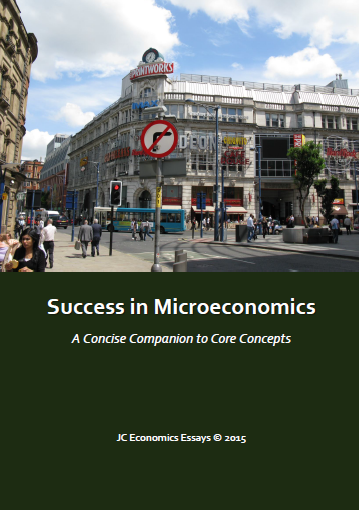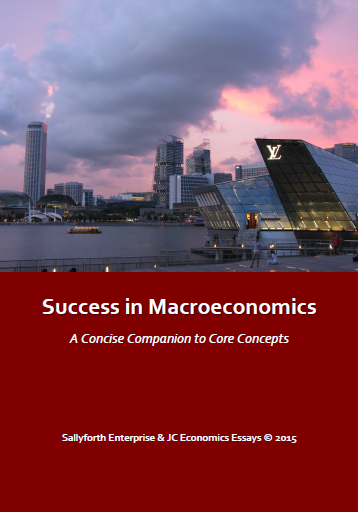This essay
argues that, while according to economic theory, a rational monopolist would set MC = MR
to maximise his profits, in the real world, firms sometimes do not want to
maximise their profits because they sometimes have alternative aims like revenue maximisation, or are often unable to because
of imperfect information and bounded rationality and depend on "rules of thumb" like cost-plus pricing.
On the
one hand, a monopolist would rationally seek to maximise profits, using the MC
= MR rule, or the profit maximisation rule (also known as the marginalist way
or principle). A monopoly is defined as one dominant firm that produces a unique good with no close substitutes, for instance, De
Beers in terms of diamonds or Microsoft in terms of the software that
it produces. The market structure that a monopolist faces generally has very high
barriers to entry, either in terms of natural barriers to entry like large
economies of scale, or man-made barriers to entry like powerful legislation and
patent rights, price setting power due to the large market share commanded by
the monopolist, and often imperfect information exists in the market, just like
it does in software and high capital-intensive technologies.
On the
other hand, in the real world, firms often do not want to maximise profits. They
may want to maximise their growth or revenue instead of profits.
To maximise their growth and expansion, they could produce
where AR = 0, which would maximise output, so as to extend their lead in the market and would thus promote the growth of their firm.
To maximise
revenue, firms could easily produce where MR = 0. This economic theory is
particularly interesting. According to the famous economist William Baumol, if
the aim of a firm is to maximise its sales instead of profits, one possibility
is that it would produce where MR = 0. This is due to the issue of the division
between ownership and control of a firm. With the separation of ownership and
control in modern corporations, the issue is that managers of a firm, like the
Chief Executive Officer or Managing Director, may seek prestige and higher
salaries by trying to expand sales even if it were at the expense of profits,
which would be shareholders’ interests. According to Baumol and Williamson,
managers may seek to maximise their own utility rather than profit-maximise, which would benefit the firm. And according
to Bearle and Means, the ownership of companies is spread out over a large
number of shareholders with little individual power, while control and decision-making
is in the hands of a few managers.
However, some firms would aim to maximise
their revenues but this would still be subject to "satisficing" – which means to
reach at least a minimum level of profit, but a level which is lower than pure
profit maximisation.
Another
reason why firms may not maximise profits is that they are unable to do so,
even if they are willing. According to Herbert Simon, decision makers face the
situation of imperfect information and have to make decisions under uncertainty
in the real world. Even though they may be rational or try to be, they
eventually use what is known as “bounded rationality”, and therefore make
decisions using the information that is available to them. Using Simon’s
theory of bounded rationality necessitating satisficing, Cyert and March argued
that real world firms aim for satisficing behaviour and even found empirical
data to support their view.
One alternative way of making pricing and output
decisions is to use cost-plus pricing, which is basically to take P = AC + a
mark up, which is why this method is called cost-plus pricing. Hall and Hitch would
agree, as they argued that company executives often make decisions using “rules
of thumb” rather than the marginalist way of MC = MR.
In conclusion,
to a large extent firms in the real world do not aim at profit maximisation in
the sense that they set MC = MR, and often are unwilling or unable to set MC =
MR. They often operate under conditions of imperfect information and make
bounded rational decisions, and may often use cost-plus pricing. However, to a
large extent, firms that do not care at all about profits would not survive in
the long run, and it is not a far stretch of the imagination to say that either
by luck or by skill, in the long run, all firms would approximately reach a level
of pricing and output that is profit maximising because firms that did not make
profits would not have survived in the long run against their more rational and
efficient competitors.
Economics
Tutor's Comment - This is an excellent effort for the A levels that answers the economics question comprehensively. Also, the use of economic theory is very strong in this economics essay. Do think of which economics diagrams are needed to be drawn and explained in this essay to make it an even stronger paper that supports your case that you are making. Thank you for reading, and cheers.
JC
Economics Essays - This useful and relevant economics essays site can help students studying economics do well at the A-Levels (Cambridge,
A1/S, A2, H1/H2/H3 levels), and the international AS level economics examinations.
IB students can also benefit from the top-quality economics content here. This economics website contributes useful economics content, lesson materials, examination tips and techniques, and model economics essays that students in both Singapore and the UK, as well as also all around the world, can use to excel in economics.
This excellent economics essay was jointly written and contributed by both SS and WT, the first, our editor of JC Economics Essays, and the second, our resident Economics
expert who helps students understand the beauty of Economics and its
applications in real life. (Some of the economics content for alternative theories of the firm was also learnt from economics modules/lessons at the University of Manchester - Business Economics in 2008.) Thank you for reading and cheers!



